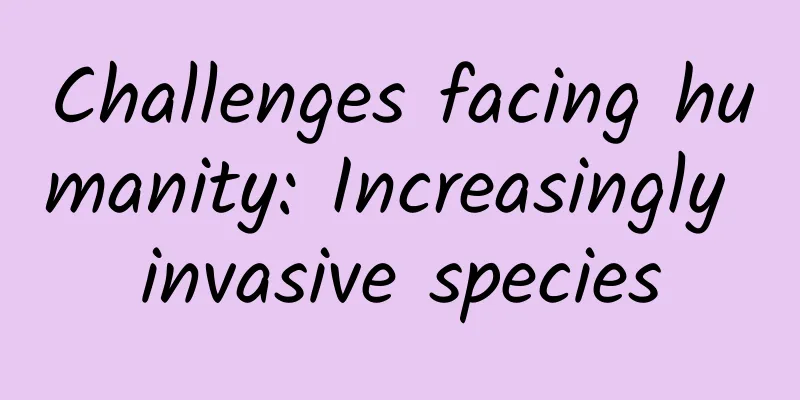Challenges facing humanity: Increasingly invasive species

|
Produced by: Science Popularization China Produced by: Feng Weimin (Nanjing Institute of Geology and Paleontology, Chinese Academy of Sciences) Producer: Computer Network Information Center, Chinese Academy of Sciences On October 11, 2021, the 15th Conference of the Parties to the Convention on Biological Diversity opened in Kunming, Yunnan. China is pushing global biodiversity governance to a new level. When it comes to biodiversity, some people may mistakenly think that the more species there are, the better, so we can introduce more new species that are not found locally. You are totally wrong to think so! The Chinese government regards biosecurity as an important part of the national security system and has elevated biosecurity to a strategic level related to national development. Biosecurity covers a wide range of content, mainly including the prevention and control of major new and emerging infectious diseases, animal and plant epidemics, the safe management of human genetic resources and biological resources, the prevention of alien species invasion and the protection of biodiversity, the prevention of bioterrorist attacks and the defense against biological weapons threats, and the biosafety management of pathogenic microorganism laboratories. Among them, the invasion of alien species is an important factor causing biosafety issues. Pandora's Box: Invasive Species As human activities have intruded into the natural world and natural resources have been wantonly exploited and exploited, the earth's ecosystem has been increasingly damaged. Many traditional food chains have been destroyed and broken, and some originally inconspicuous organisms have become rampant due to the lack of natural enemies. At the same time, the frequency of species invasions has increased dramatically, further damaging the ecosystem and forming a vicious cycle. Beware of invasive species (Image source: Conservation Corridor) The concept of invasive species was proposed Pehr Kalm, a Swedish-Finnish man, was probably the first person to systematically study invasive species. As early as the 17th century, he discovered and recorded 15 plants, bees, and some insects that originally lived in Europe in the Americas. Darwin also described the phenomenon of biological invasion in "The Origin of Species", but did not clearly put forward the concept of biological invasion. The British ecologist Charles Elton first formally proposed the concept of biological invasion in his book "The Ecology of Plant and Animal Invasion" published in 1958, and defined it as: a certain organism spreads from its original distribution area to a new (usually distant) area, where its offspring can reproduce, spread and survive continuously. The book reviews all aspects of biological invasions, and explains the reality and consequences of species invasions and changes in ecosystems faced by humans. As a result, Charles Elton is known as the founder of invasion biology. The book is also mentioned together with Silent Spring and is considered a must-read book for understanding future environmental disasters. Charles Elton, Invasion Ecology (Image source: provided by the author) Invasive species spread around the world Species invasion occurs throughout the world, but the types of invasive species, pathways and methods of invasion, and the impacts they bring vary in different regions, such as continents, oceans, and islands. (1) Invasive alien species in mainland China There are six continents on the earth. The vast continents are where terrestrial animals and plants reproduce and grow. They migrate back and forth with climate change, adapt to the new environment and expand their distribution. Such migration can also be regarded as species invasion under natural factors. In the past, natural barriers such as mountains, freshwater lakes and islands hindered the free migration of animals and plants. However, with the development of human civilization, international trade and tourism industries have become increasingly developed, and the factors that were originally regarded as geographical barriers have been largely eliminated. International trade (Photo source: veer photo gallery) On the contrary, species invasion caused by human factors is becoming more and more common, and the damage to local ecosystems is becoming more and more prominent. Historically, people's trading activities in the planting industry may have pioneered the introduction of plant species, such as crops, flowers and trees, and subsequently led to the introduction and spread of animal species. Since ancient times, tens of thousands of species have been introduced to the world, which often leads to the danger of species invasion. Species invasion is like water flow, which is just a small stream at the beginning, but once a considerable population is formed, it will gather into a torrent and become uncontrollable. Unless the species is restricted by the natural environment or affected by genetic factors, the development of the population size will become unstoppable and species invasion is inevitable. (2) Invasive marine species The vast ocean is an open ecosystem and the destination of thousands of rivers from the continent. As the world's oceans are separated by continents, coupled with constraints such as water temperature and ocean currents, they have gradually formed their own unique indigenous biomes, and these constraints have also affected the further spread of local species. Image source: veer gallery Thus, different marine biotas have evolved in the oceans over a long period of time. However, this naturally formed biota pattern is also being increasingly affected by the increasing activity of human marine transportation. Under the background of the development of world trade and economic globalization, human marine transportation is very busy. Some marine organisms are also spread to foreign lands where they should not be through ship ballast tanks, ship bottom parasites, artificial seawater aquaculture and straits and canals, bringing hidden dangers to the local ecology. Among them, ballast water is an important way to spread harmful aquatic organisms and pathogens. According to statistics, more than 80% of the world's international trade volume depends on shipping, there are more than 50,000 merchant ships engaged in international trade transportation, and the annual discharge of ballast water reaches 12 billion tons. "Ballast water" refers to the water and its suspended matter added to a ship to control the ship's trim, heel, draft, stability or stress. Ship ballast water, as a carrier of alien marine species, is listed by the Global Environmental Protection Fund as the top of the "four major hazards" to today's oceans. Ballast water (Image source: mfame.guru) According to analysis by relevant departments, the invasion of alien marine species has become one of the four major problems facing the world's marine ecological environment (invasion of alien species, marine pollution, overfishing of fishery resources and habitat destruction), and has become the second major threat to the world's marine ecological environment after the destruction of marine habitats. It may have direct or indirect impacts on the marine ecosystem, such as inter-species competition destroying the ecological environment, hybridization with native species causing genetic pollution, and pathogenic organisms and toxic algae leading to aggravated marine ecological disasters. Therefore, the invasion of alien marine species has become one of the most serious global environmental problems. (3) Invasive alien species on islands The world's islands account for only 5.3% of the total land area, but they are the hardest hit areas by species invasion. According to a survey conducted by scientists on islands around the world, the loss of global biodiversity is growing disproportionately rapidly on islands, with the invasion of alien species being the main driving force for species extinction on islands. Historical data show that 75% of the extinction cases of birds, mammals, amphibians and reptiles since 1500 have occurred on islands. Currently, more than one-third of the species on the IUCN Red List of Threatened Species also live on islands. Island (Photo source: veer photo gallery) The threats to island ecosystems mainly come from human behavior. People intentionally or unintentionally bring various animals to islands, among which the most dangerous alien species are wild cats, dogs, rats (gray rats, black rats, small rice rats), mongooses, goats and pigs. In the 3,990 case studies that have had a negative impact on island ecosystems, experts found that these eight species accounted for 83%. Unprecedented human invasion Human expansion is undoubtedly the largest species invasion in the history of the Earth. Although humans have only 7 million years of evolutionary history, the intensity and scope of their invasion clearly exceeds the impact of invasions by other animals and plants on Earth. Moreover, the impact that humans have brought to the Earth's biosphere is also the most profound and long-lasting. (1) Human expansion hastened the fate of contemporary organisms In the journey of leaving Africa and heading to the world, humans overcame numerous difficulties and obstacles and finally reached the advanced stage of human society. However, the path of human expansion and development also caused the tragic fate of many creatures. The most typical event was the extinction of some species caused by the Europeans' voyages in the 16th century. During the voyages of Europeans, many plants and animals suffered catastrophic disasters, the most famous of which were the great auk, the dodo, the moa, the passenger pigeon, etc. In the late 16th century, European colonists armed with rifles and hunting dogs settled in Mauritius, and from then on, doom came for birds like the dodo that could neither fly nor run fast. Restoration of the Dodo (Photo credit: provided by the author) The pigs, dogs, monkeys, rats and other animals brought by the colonists began to prey on the eggs and chicks laid by the dodo on the ground, seriously affecting the reproduction of the dodo's offspring. In addition, the colonists also cut down forests on a large scale, destroying the dodo's habitat. What's worse, they slaughtered the dodo, whose meat was tender and delicious. By around 1690, the dodo, a bird that had only been discovered by humans for 70 years, had become extinct. The passenger pigeon is another bird species that has become extinct. It is a type of pigeon that particularly likes to travel, hence its name. In the 17th century, technologically advanced Europeans occupied America and cut down forests, leaving passenger pigeons without habitats. Passenger pigeons became food for these pioneers because of their delicious meat. When the meat of passenger pigeons became widely accepted by the public, large-scale commercial hunting began. By the end of the 17th century, there were no passenger pigeons in large flocks in America except Michigan. By 1900, this species of pigeons, which once numbered in the billions, was declared extinct in less than a century due to the frenzied slaughter by humans. The passenger pigeon of the past (Image credit: Tim Hough) New Zealand was once an archipelago that had been sealed for more than 60 million years. Over the long course of history, New Zealand has developed its own unique fauna, with a handful of mammals, numerous endemic birds, amphibians, reptiles and insects: the world's tallest bird - the moa, primitive New Zealand frogs, New Zealand monitors and the long-bearded wingless locust - a 71-gram sand weta, etc. However, when people first set foot in New Zealand, they also brought disaster to this natural treasure trove of flora and fauna. Within 1,000 years of human arrival, 32% of land birds and 18% of marine birds became extinct, and the cause was actually caused by the introduction of house mice, cats, dogs, brush-tailed possums, stoats, weasels, and other mustelids. In the Hawaiian Islands in the Pacific Ocean, snakes and rats accidentally brought by human activities have also caused a devastating blow to local native birds. Because the local birds have never seen these predators for generations, they have no ability to resist, and only death awaits them. In short, as the pace of human expansion spreads to all parts of the world, species in many places have been affected and even destroyed by alien species, and have retreated and shrunk, and finally become extinct. (2) Improper human activities seriously disturb the balance of nature With the development of human society and the substantial increase in population, the living territory of human beings has been expanding. In order to obtain the natural resources of the earth, people have marched into the wilderness and into the hinterland of the continent to explore, reclaim wasteland, and build new homes and production bases. The lush land has left its mark everywhere. With the pace of human expansion, the wilderness that had been silent for many years was awakened, the natural ecology formed over millions of years was disintegrating, and many animals and plants, including invisible microorganisms, were migrating to other places. Human expansion behaviors and methods are diverse. For example, deforestation and reclamation of grassland vegetation. This kind of human interference has caused harm to the natural environment since early agriculture about 10,000 years ago and continues to this day, not only leading to the degradation of forest vegetation, aggravating soil erosion, and changes in the regional environment, but also causing the destruction of many biological environments and the loss of biodiversity. For example, environmental pollution. Human industrial production has generated a large amount of industrial waste and discharged a large amount of toxic pollutants into the natural environment, which not only pollutes the air, but also the sulfur oxides and nitrogen oxides that enter the atmosphere combine with water vapor to form highly ionized sulfuric acid and nitric acid, leading to increased atmospheric acidity. In many areas, acid rain has even become a disaster, bringing catastrophic effects on ecosystems and soil. For example, collecting wild animals and plants. Among the traditional medicines taken orally by 80% of the world's population, 85% are related to wild animals and plants. Some economic, medicinal and rare wild materials have been plundered and collected by people since ancient times, causing the extinction of some species. For example, driven by profit, some people speculated at high prices and poached wild orchids, causing wild orchids to be on the verge of extinction. Hunting is another example of a special form of interference. Humans’ unplanned hunting for economic and food purposes, especially the killing of endangered animals with small populations, has also seriously damaged the reproduction and growth of animal populations, and even caused the extinction of species. (3) Mistakes in the governance of human society In the process of human social governance, wrong decisions often lead to a series of species invasion incidents with serious consequences. People introduced alien species for certain needs, such as for breeding, flower planting, etc.; in addition, there were also introductions for purposes of biological control, greening, soil and water conservation, and environmental protection. However, if there is a lack of management and alien species are introduced blindly for quick success, the result will be that a good thing will turn into a bad thing. For example, in order to control the spread of aquatic plants such as algae, manage rivers and clean water bodies, the United States introduced eight species of fish from Asia in 1970, including grass carp, bighead carp, silver carp, and carp, and collectively called them "Asian carp." But what people did not expect is that the harm caused by these fish is far greater than the effect of their introduction. Although Asian carp eat a lot of aquatic plants, plankton or wild clams, their strong appetite also takes away food from some local fish species, seriously deforming the development of the local ecology. Today, carp are infesting American rivers, causing widespread flooding. In order to control the rampant growth of wild rabbits, the Australian government introduced cane toads, which were later released into Queensland sugarcane plantations to control pests. By 1937, more than 60,000 young toads were used to prey on insects, but the sugarcane plantations could not contain them, and they often ran out to harm other animals and plants. As a result, the introduction of the cane toad became one of the top environmental policy mistakes of the Australian government, causing ecological havoc comparable to the introduction of the rabbit into the country. my country's animal husbandry has been overgrazing for a long time, resulting in grassland degradation. This has led to a strong demand for new high-quality fast-growing forage in various regions, and this has also provided an excellent opportunity for foreign grass seed companies to dump grass seeds into China. However, there are also many examples of invasions caused by introduction as forage or feed: water peanut, purple alfalfa, white sweet clover, sunflower, millet, timothy grass, pasture grass, Sudan grass, Persian ryegrass, big floating grass, barley grass, water hyacinth, etc. have all affected the stability of my country's ecological environment to varying degrees. Water hyacinth, whose scientific name is "Water Hyacinthus", is native to Brazil. It likes warm, humid and sunny places. Even if the temperature exceeds 35℃ and is lower than 10℃, it will not hinder its growth. In the early 20th century, water hyacinth was introduced to China as a flower. But who could have imagined that a water hyacinth plant could breed a pond of water hyacinths? Water hyacinth (Photo source: provided by the author) This species, which was originally used to purify water, has now become a "disaster star" that pollutes water and induces pathogens and insect pests. It has become the number one enemy in the fields of agriculture, water conservancy and environmental protection in various countries. It has completely "turned over". If we only focus on introducing alien species without considering their consequences and strengthening effective management, species invasion is inevitable. For example, in the 20th century, in order to obtain high-quality honey, Brazil introduced European bees and African bees for hybridization. The hybrid offspring are Brazilian bees. Brazilian bees have high honey production and good quality, which has brought huge economic benefits to Brazil. However, the introduced African bees are also known as killer bees. This type of bee is highly poisonous and can sting humans and animals to death. Therefore, when they mate and reproduce with local wild bees, they cause the "killer bee" disaster that has lasted for 30 years. my country introduced Italian bees with high honey production in the early 20th century, but this also produced unexpected adverse consequences. It destroyed the habitat of local Chinese honey bees, interfered with their mating, and caused a rapid decline in the local Chinese honey bee population. The alarm bell for biosafety in the 21st century! After the emergence of human beings, after millions of years of evolution, the development pattern of modern society was formed. However, humans did not stop exploring and expanding into every corner of the Earth with the establishment of social civilization. This caused a series of chain ecological and environmental changes with far-reaching impacts, and brought about endless species diffusion and counter-invasion events, which humans were exhausted from coping with and caused endless troubles. (1) Modern transportation exacerbates species invasion With the advancement of modern technology, transportation tools are changing with each passing day. Bicycles allow people to travel freely within a few kilometers, cars expand people's activity space to dozens of kilometers, and trains and airplanes transport people easily and quickly to places hundreds or even thousands of miles away. Image source: veer gallery Therefore, humans can almost invade any area they want to enter at will. However, the pace of human progress is accelerating, and the impact on the world is also increasing, and the biological world in particular feels an unprecedented threat. On the one hand, human expansion is a form of invasion. To a large extent, it has crossed into the homes of many animals and plants on which they have depended for generations, and has infringed on their originally natural and harmonious ecological environment. On the other hand, species invasions caused intentionally or unintentionally by humans have brought unpredictable consequences to local species. At the same time, due to convenient transportation, interpersonal interactions have become more frequent and social activities have become more active, which has invisibly fostered a global virus infection market, allowing the virus to spread rapidly to countries around the world in a very short period of time. The new coronavirus that broke out in early 2020 and is still raging around the world has spread to all parts of the world with the help of convenient human transportation such as airplanes and trains, causing countless people to fall into the fear of death and the torture and pain of illness. (2) Species invasions bring plagues Species invasions caused by increasingly frequent human exchanges and improper production activities have become the main route of modern species invasion. Many species spread from their original distribution areas to new areas, causing many biological invasions. These rash intruders settle, reproduce and spread in the local natural or artificial environment, eventually destroying the ecological balance of the area and causing devastating blows to native species. The global mass extinction of amphibian species living on multiple continents was caused by the chytrid fungus. Originally found only in Africa, the fungus was accidentally brought to the Americas and Europe by humans. This parasite spread among amphibians that had no resistance, causing a large number of amphibians to die, and many frogs in the Americas and Australia became extinct. Batrachochytrium dendrobatidis (Photo source: veer photo library) Today, chytrid fungus has affected as many as 30% and as many as 50% of frog species. The mass extinction of bats in North America was also caused by a fungus called Geotrichum destructans. Some of human beings' unconscious behaviors have become a sword hanging over the heads of many species. In the era of globalization driven by humans, the invasion of alien species is becoming more and more frequent, and the living environment of the original "indigenous" organisms is facing severe challenges. Microorganisms such as chytrid fungi that are difficult to detect with the naked eye may endanger the survival of other organisms at any time. These pathogenic microorganisms themselves may be the product of the highly developed human civilization. Humans are increasingly invading the natural habitats of animals and plants to meet their needs in life. At the same time, pathogenic microorganisms that naturally live in animals and plants are gaining more and more opportunities to invade the human body. The highly densely populated environment and highly developed network of people and material flows in the human world provide a breeding ground for the spread of pathogens. Countless organisms were eventually eliminated because of these invisible "forces", and we humans may not be immune to them either. (3) Species invasions have repeatedly sounded the alarm for biosecurity More than 20 years ago, mankind entered the 21st century with a beautiful dream for the new century. Thanks to the rapid development of modern science and technology, people are full of confidence in the future, the wave of globalization is sweeping the world, and the world's economic and social development has entered a fast track of development. However, the great development of the world economy has always been at the expense of natural resources and the damage to the natural environment. The pace of human expansion has inevitably touched the microorganisms lurking in every corner of nature. When the balance of the ecosystem formed over thousands of years is destroyed, the invisible black hand quietly stretches out its claws, and the harmful bacteria and viruses in the microbial family begin to launch waves of counter-invasion against humans. Therefore, when mankind entered the 21st century, it was constantly attacked by pathogenic microorganisms, the frequency, impact, scope and depth of the disaster were unprecedented in human history. The rounds of epidemic disasters caused by SARS, avian influenza, Ebola virus, Zika virus, Middle East Respiratory Syndrome and the new coronavirus have come one after another, like falling from the sky and rushing rapidly, sounding one alarm bell after another for mankind! Human beings have experienced an unprecedented high frequency of microbial disasters since the new century. As my country opens up to the outside world and foreign exchanges increase, the probability of alien species entering my country is also increasing. On May 18, 2020, the Ministry of Ecology and Environment released the 2019 China Ecological Environment Bulletin, announcing that more than 660 alien invasive species have been found in China, indicating that my country is one of the countries most seriously affected by alien species invasion. With the acceleration of international trade and global economic integration, the situation of biological invasion will become increasingly severe. The invasion of alien species in my country has shown a trend of increasing number, accelerating frequency, expanding scope, intensifying harm and increasing economic losses. Alien species have seriously damaged the ecosystems in many parts of my country and have also caused huge economic losses of more than 200 billion yuan per year. The alarm bells for biosafety have been sounded again and again. Human activities and behaviors are causing more and more species invasions. The ecological crisis caused by species invasions will eventually backfire on humans themselves and affect the healthy development of human society. The 15th Conference of the Parties to the United Nations Convention on Biological Diversity (COP15) held in Kunming, China, demonstrated the spirit of cooperation among mankind to jointly maintain biodiversity. To this end, mankind should further strengthen international cooperation, and countries should build a solid wall of biosecurity through laws, mechanisms, means and the application of new technologies, protect biodiversity, maintain ecological balance, and create a good home for mankind on Earth. Image source: veer gallery References: 1. Charles Elton, 2003. Ecology of plant and animal invasions (translated by Zhang Runzhi et al.). China Environmental Science Press. |
<<: What? Three-quarters of shark species are endangered? They are also a great threat to humans
Recommend
Korla Mini Program Development Company, how much does it cost to develop a digital mini program?
More and more businesses are paying attention to ...
Guangzhou WeChat knowledge payment mini program? What are the advantages of the knowledge paid reading store mini program?
With the development and growth of the market eco...
Xiaomi YU7 starts large-scale road testing. Can it successfully compete with Tesla Model X when it is launched next year?
Xiaomi's first SUV, the YU7, is undergoing la...
Will cars become less safe after being lightweight? Safety and lightweight can be improved together
One of the development directions of the automobi...
How to create a successful event promotion?
Every time a large-scale event is held, many oper...
The moon is shrinking all the time. Will it shrink into the size of a raisin?
Produced by: Science Popularization China Author:...
How do Tencent designers optimize designs? This case study is so vivid!
Usually the designs I make are relatively simple ...
Why is there always a queue in the women's restroom? What do girls do in there?
Follow "Body Code Decoding Bureau" (pub...
Foreign experts discuss ASO: How do they perform search optimization?
How to do a good job of search optimization ( ASO...
The most in-trend information flow advertising marketing plan, take it for free!
Today I’d like to share with you a complete templ...
Useful information + cases | In-depth analysis, how to punch in and sign in effectively?
What I want to share today is “punching in and si...
How to write a successful operation and promotion plan?
In the process of making the plan , I discovered ...
iOS/iPadOS 15.2 Beta 3 is here!
According to macrumors, Apple today released the ...
Momo promotion: Momo product analysis report!
Momo is a pan-entertainment and pan-social platfo...
Of the three great Android kingpins, only one is left
As early as in native Android 9.0, the traditiona...









